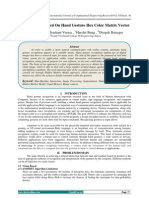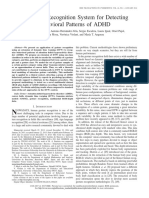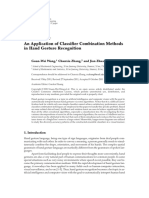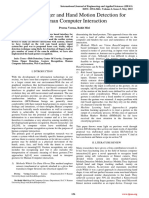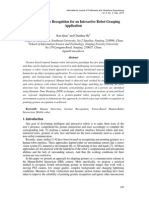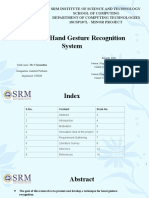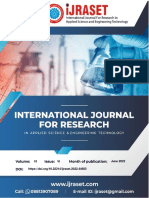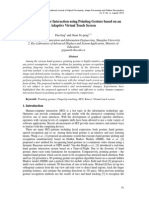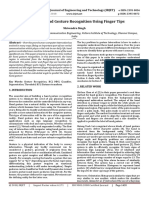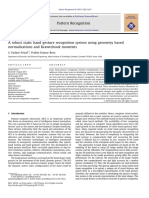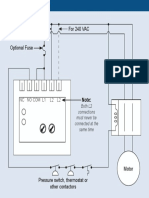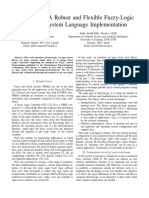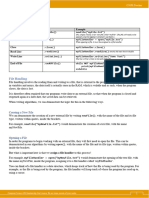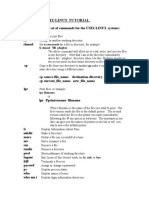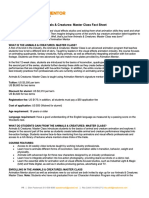© Springer-Verlag London Ltd
Virtual Reality (1998) 3:112-119
An E icient Posture
Recognition Method
Using Fuzzy Logic
E. K. H. Tsang, H. Sun
Department of Computer Science and Engineering, The Chinese University of Hong Kong,
Shatin, Hong Kong, China
Abstract: Computer-human interaction plays an important role in virtual reality. Glove-based input devices have many
desirable features which make direct interactions between the user and the virtual world possible. However, due to the
complexity of the human hand, recognising hand functions precisely and efficiently is not an easy task. Existing algorithms
are either imprecise or computationally expensive, making them impractical to integrate with VR applications, which are
usually very CPU intensive.
In the problem of posture and gesture recognition, both the sample patterns stored in the database and the ones to be
recognised may be imprecise. This kind of imprecise knowledge can be best dealt with using fuzzy logic. A fast and simple
posture recognition method using fuzzy logic is presented in this paper. Our model consists of three components: the
posture database, the classifier and the identifier The classifier roughly classifies the sample postures before they are put
into the posture database. The identifier compares an input posture with the records in the identified class and finds the
right match efficiently. Fuzzy logic is applied in both the classification and identification processes to cope with imprecise
data. The main goal of this method is to recognise hand functions in an accurate and efficient manner. The accuracy,
efficiency and the noise tolerance of the model have been examined through a number of experiments.
Keywords: Human-computer interaction; Hand posture recognition; Fuzzy logic; Posture commands
Many VR applications require users to wear head
Introduction mounted displays or gloves. The keyboard becomes
unreachable to the user visually or physically. One
Computer-human interaction is one of the most common solution is to place 3D widgets in the
important issues in virtual reality. As mentioned by virtual scene for controlling these applications.
Gomez et al. [1], there are a number of basic However, these widgets may occlude other parts
concerns about 3D interaction with users. The most of the virtual scene. Therefore, hand function input
general one is the interaction capability of the users. methods, such as posture and gesture commands,
Among various 3D tracking devices, glove-based are introduced to replace the 3D widgets.
devices possess many desirable functions, such as Another concern mentioned by Gomez et al. is
grasping and deforming virtual objects, that other the processing power of computers. VR applications
3D input methods cannot compete with. on the one hand have to maintain a reasonably high
IP
� frame rate, and on the other hand, have to compIete t:uzzy set is the superset of traditional set theory.
a lot of tasks, such as rendering and collision detec- It was introduced to represent vagueness in everyday
tion, in reaI-time. The CPU time and other resources life [t 0]~ In traditional set theory, the membership
allocated to each task is definitely limited. It is relation is defined clearly as true or false. However,
impossible to devote a large portion of computation in fuzzy logic, the degree of membership is used,
resources to analyse the hand functions. Practical instead of true and false. For example, we would
algorithms for posture and gesture recognition must say, '5.5 is within 6 and 8 with a certainty 0.3',
be simple and require small amount of resources. rather than '5,5 is not within 6 and 8'. The degree
The maior problem of posture recognition comes of membership, usually caIled certainty factor, is
from the complexity of the human hand, which has defined by membership functions.
about 30 degrees of freedom. About 20 input para- As illustrated in the above example, imprecise
meters are needed to describe a specific posture. or incorrect data are considered to be partially
Another problem is the tack of an accurate measure. correct, rather than simply discarded. The certainty
Both the sample patterns stored in the database factor shows how 'correct' a piece of information
and the ones to be recognised may be imprecise is, This is why fuzzy logic is capable of handling
due to mechanical noise or human factors. Even imprecise knowledge. Fuzzy models have been
the same person cannot repeat a posture exactly, successfully applied to many pattern recognition
which must be slightly different from the original problems, such as handwriting recognition [11]
one. Gesture recognition faces extra difficulties such and speech recognition. The concept of fuzziness
as time-varying input signals and gesture segmenta- improves the tolerance of noise or imprecise data
tion. In general, gesture commands are more of these systems.
intuitive, while posture commands are tess complex. The following sections describe the objectives
A detailed analysis of some approaches to of the research; the hand posture recognition
posture and gesture recognition is given by Watson model using fuzzy logic; this is followed by a
[2]. Approaches mentioned include template match- discussion of the experimental results, and an
ing [3], neural networks [4, 5], statistical classifica- evaluation of work done.
tion [6] and discontinuity matching. These methods
have their own pros and cons~ The first approach is
simple and efficient, but fails to provide accurate
results. Neural networking is highly tolerant of noise
Objectives
and incomplete data. However, this approach has a
number of disadvantages. The training phase is too As mentioned in the previous section, there are still
long, and a large set of labelled examples is needed. many problems in existing approaches that make
Manual tuning of parameters is required and there them impractical for integration with VR applica-
is no obvious rule which guides the tuning and tions. They are either intolerant of noise or not
design of the network architecture. Adding new efficient enough. We aim at solving both problems
records may require retraining, or even redesign of at the same time. Our objectives are listed below:
the network architecture. The problems of statistical • The system should be capable of dealing with
classification are similar to the previous method. imprecise data.
Discontinuity matching requires a lot of computation
• The recognition process should be efficient and
and thus cannot be integrated with VR systems.
occupy little CPU time.
More recent approaches include model-based
analysis for hand postures by Lee and Kunii [7] and • The system should be flexible, It should work
Hidden Markov Model (HMM) for gesture recog- with any set of postures without any modifica-
nition by Liang and Quhyoung [8] and Nam and tion, Moreover, the size of the posture database
Wohn [9]. The first one uses an iterative improve- should have little effect on the performance.
ment approach and it takes a long time to recognise
a posture. The success of HMM in handwriting and
speech recognition has drawn researchers' attention Fuzzy Logic Posture
recently. HMM is able to extract and recognise a
dynamic pattern. However, similar to the neural Recognition
network approaches, the system design and training
algorithm may not be obvious and manual tuning Our model consists of three major components:
is needed. the posture database, the classifier and the identifier.
An Efficient Posture Recognition Method Using Fuzzy Logic

